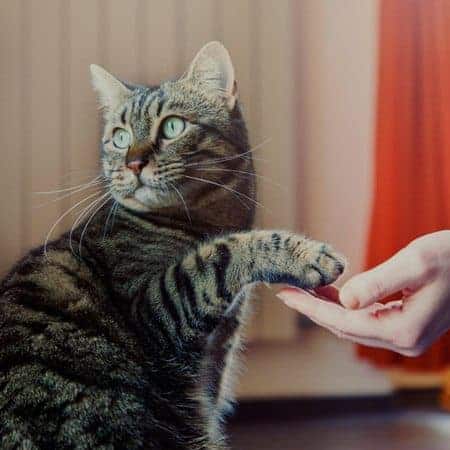Catch the ball, kitty! Fetch the newspaper, kitty! Snag the Frisbee, kitty! Those aren’t commands you’re likely to be issuing to your cat anytime soon – at least not with any success. Cats aren’t exactly receptive to that kind of training.
But that doesn’t mean you can’t train your cat at all. You can, and very effectively. And in the process you can teach your cat to be a much more pleasant member of your household.
Probably the very first training you’ll want to give your cat will be in using the litter box – for very obvious reasons!
LITTER BOX TRAINING
Training a cat to use a litter box usually isn’t difficult. Cats are generally clean by nature, and have a natural inclination to bury their waste. Use the following steps to train your cat to start using a litter box:
- Place your cat and a clean litter box (the kind without a cover) in a confined area, like a room in your house.
- Be sure your cat has plenty of food and clean water.
- If your cat ‘goes’ outside of the box, place the waste in the litter box. (Sorry – needs to be done! The smell of the waste may encourage the cat to start using the box.)
- Usually within a day or two of being confined with the litter box the cat will begin to use the box regularly.
If the cat isn’t using the box within a couple of days, try this: After the cat has eaten, place the cat in the litter box and then just scratch the surface of the litter a bit with your fingertip.
If it’s still a no-go, make sure the box is clean. If it’s ever been used before, clean it with baking soda and fill with clean litter. You can also try several types of litter; sometimes a cat will be fine with one brand and turn up its nose at another brand. Also make sure that the box is located in a quiet, secluded area.
If nothing seems to work, consult your vet. Occasionally an underlying medical problem can be the cause of a cat’s reluctance to use a litter box.
BEHAVIOR TRAINING
If your cat is doing some things that, well… you’d REALLY prefer it didn’t do, there’s a good chance that you can train that bad behavior away.
But first, try to understand why the cat is behaving that way. There’s a reason, and from the cat’s perspective, of course, the behavior is perfectly reasonable.
If the cat is clawing your furniture, for example, it’s driven by instinct to do that. It needs to claw something – it’s a survival instinct. Doesn’t have to be your furniture, but something!
So there’s not much chance of getting your cat to stop clawing. But you can train the cat to focus its clawing instinct on acceptable objects, like scratching posts.
Train your cat to behave appropriately by using positive reinforcement, not punishment. DON’T hit the cat when it scratches the furniture. The cat won’t understand the reason for your behavior, and will just learn to fear you. Instead, reward your cat by giving it a treat when it claws the cat tree.
DISCOURAGING AGGRESSION
If your cat sometimes plays too rough, and begins biting or scratching, that’s also a behavior that can be trained away – at least to a degree.
When you’re playing with your cat and it begins biting or scratching, startle it with a loud noise. You can clap your hands or make a hissing sound – just something to startle the cat into stopping what it’s doing.
And then just simply walk away.
Do that every time that your cat gets rough, and it will learn that the consequence of biting and scratching is that playtime comes to an end.
YOUR CAT DOESN’T KNOW IT CAN’T BE TRAINED
It’s a common misconception that cats can’t be trained. But fortunately that’s just not true. You can and should train your cat to be a more pleasant member of the household. You’ll both be better off.
And believe it or not, you can even train your cat to perform some ‘dog like’ tricks if you want. You can train your cat to sit on command, or to walk on a leash. You can even train them to play the piano!
Better start with the basics though. Get that litter box training done first!









